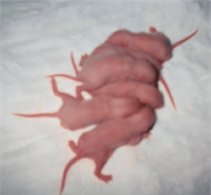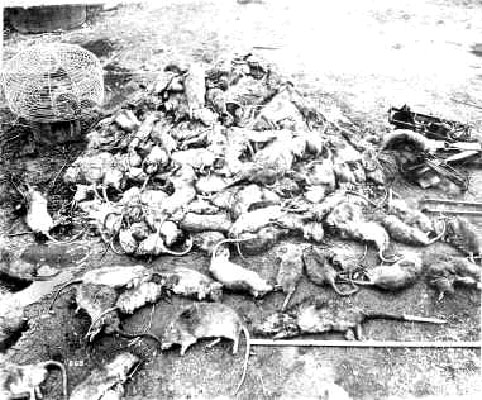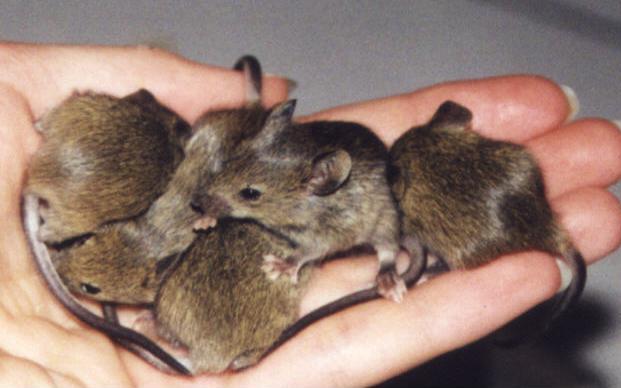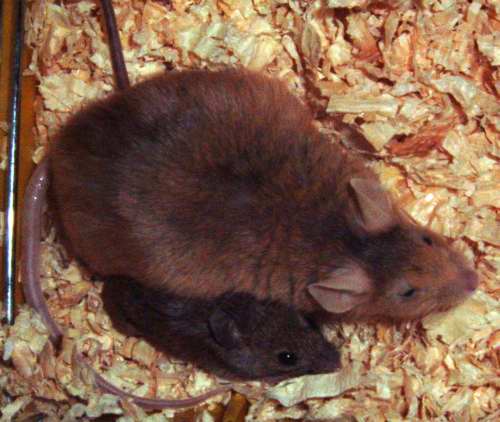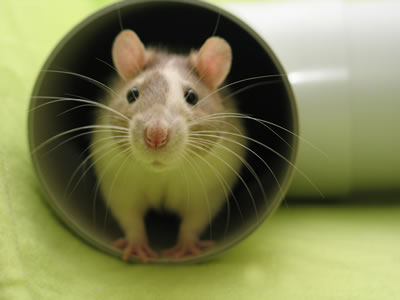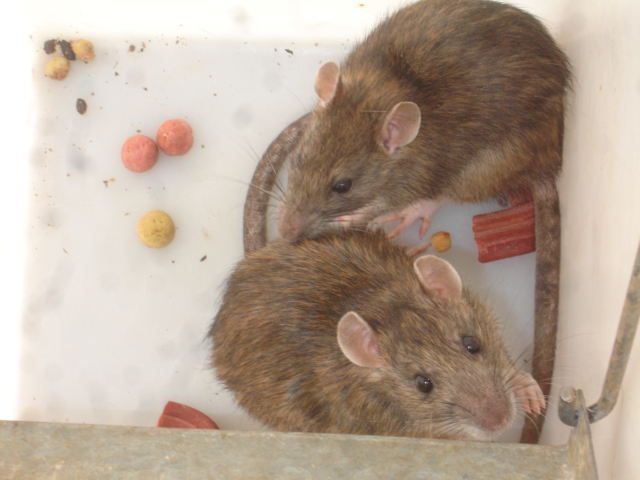
| Spiders
| Bats | Snakes
| Ants | Cockroaches
| Leeches | Rats &
Mice
Scientific
name: Rattus Norvegicus - Brown (or Norway) Rat, common pet
Description:
Environment:
Care
and feeding:
Social
Behaviors:
Handling
and Training:
The Bubonic
Plague of 1900
Quarantine areas were established. These stretched from Millers Point east to George Street, along Argyle, Upper Fort, and Essex Streets then south to Chippendale, covering the area between Darling Harbour and Kent Streets, west to Cowper Street, Glebe, along City Road to the area bounded by Abercrombie, Ivy, Cleveland Streets, and the railway. The area east from George Street enclosed by Riley, Liverpool, Elizabeth and Goulburn Streets, Gipps, Campbell and George Streets were also quarantined, as were certain areas in Woolloomooloo, Paddington, Redfern and Manly. Cleansing and disinfecting operations in the quarantine areas lasted from 24 March to 17 July and included the demolition of 'slum' buildings. Photographs were taken of buildings before demolition and inspectors took notes of other property destroyed. The photographs also include the interior and exterior of houses, stores, warehouses and wharves, and surrounding streets, lanes and yards, thus providing a fairly clear indication of the state of the city during and immediately after the Plague. Local residents were employed to undertake the cleansing, disinfecting, burning and demolition of the infected areas, including their own homes. Shovels, brooms, mattocks, hoses, buckets, and watering cans, were tools used to clear, clean, lime wash and disinfect. Not only buildings and dwellings were subjected to the cleansing operations but also wharves and docks were cleared of silt and sewerage. Cleansing agents used during the cleansing operations included: solid disinfectant (chloride of lime); liquid disinfectant (carbolic water: miscible carbolic, 3/4 pint water, 1 gallon); sulphuric acid water (sulphuric acid, 1/2 pint water, 1 gallon); carbolic lime white (miscible carbolic 1/2 pint to the gallon). Rat catchers were employed and the rats burned in a special rat incinerator. Over 44,000 rats were officially killed in the cleansing operations.
In 1901
the Sydney Harbour Trust resumed hundreds of properties in The Rocks and
Millers Point. While public health was a convenient excuse for resumptions,
the need for a harbour bridge may also have motivated the authorities.
Green Bans in the 1970s on the redevelopment of The Rocks helped preserve
this historic area which is now a major tourist attraction. The Rocks area
has been under the control of the Sydney Cove Redevelopment Authority since
1970 and the Sydney Harbour Foreshore Authority since 1999.
Rats and Sound Scientific Research The federal Animal Welfare Act (AWA) sets minimum standards of animal care for experimental laboratories, animal dealers, and others. In 1970, the AWA was specifically amended to protect all “warm-blooded animals” used in research, but regulations promulgated excluded rats, mice and birds. Now, the vast majority of scientists and laypersons agree that it is time to include experimental rats, mice and birds in the regulations for enforcement of the Act. In 1966
and again in 1985, Congress contemplated and rejected the utilization of
either accreditation or NIH policies as a means to ensure compliance with
the Animal Welfare Act. Both NIH and the Association for the Assessment
and Accreditation of Laboratory Animal Care, International (AAALAC) have
repeatedly stated that they are not enforcement agencies. USDA is the only
federal agency with the sole responsibility of enforcing legally mandated
animal care requirements at registered research facilities. USDA’s track
record for the species it currently covers far exceeds that of either NIH
or AAALAC. In addition, since hundreds of laboratories that use rats, mice
and birds fall outside of NIH or AAALAC purview, the care and treatment
of animals is unknown.
“Rats, mice, and birds account for about 90% of all laboratory animals in the United States. And yet these animals—upon whom we rely so heavily in our biomedical research and product safety testing—are not covered by regulations designed to enforce the Animal Welfare Act (AWA), the principal law governing the care and treatment of research animals in this country. The Advisory Board of the Johns Hopkins Center for Alternatives to Animal Testing (CAAT) finds this situation untenable….The CAAT Board sees no scientific or ethical basis for this exclusion.” —Statement dated December 4, 2001 from the CAAT Advisory Board [G Adam-Rodwell, PhD (Mary Kay Holding Co.), LS Andrews, PhD (Rohm & Haas Co.), AE Auletta*, PhD (US Environmental Protection Agency), FW Baker, PhD (Procter & Gamble Co.), MO Barker, PhD (Mary Kay Holding Co.), R Bascom, MD, MPH (Penn State University), JL Butenhoff, PhD (3M), WE Dressler, PhD (Bristol-Myers Squibb Co.), J Foster (Charles River Breeding Laboratories, Inc.), JJ Freeman, PhD (ExxonMobil Biomedical Sciences, Inc.), AJ Gandolfi, PhD (University of AZ), AM Goldberg, PhD, DScHc (Johns Hopkins University), AW Hayes, PhD (The Gillette Co.), H Koeter, DrTox (Organization for Economic Cooperation and Development), R Main, MS, MPH (Alberto-Culver Co.), JP McCulley, MD (University of TX), KS Ramos, PhD (TX A & M University), B Robaire, PhD (McGill University), NR Rose, MD, PhD (Johns Hopkins University), AN Rowan, DPhil (Humane Society of the US), DN Sauder, MD, FRCPC (Johns Hopkins University), LM Schechtman*, PhD (US Food & Drug Administration), SA Shaya, PhD (Johnson & Johnson), WS Stokes*, DVM (National Institute of Environmental Health Sciences), GI Tennekoon, MBBA, LRCP (University of PA), EL Thompson (Bernice Barbour Foundation, Inc.), and JD Yager, PhD (Johns Hopkins University)] *Ex officio * “As a matter of principle, DPC [Dupont Pharmaceutical Co.] does not oppose including research rats, mice and/or birds in the AWA [Animal Welfare Act] regulatory definition of animals.” —David Martin, VMD, Senior Director, Animal Resources, Dupont Pharmaceutical Co., Wilmington, DE, May 24, 1999 * “At TARC [Torsten Almen Research Center], laboratory-bred rats and mice comprise over 90% of the species used in our biomedical research and development animal studies. The future use of laboratory-bred rats and mice will escalate especially in the fields of molecular biology, transgenic animal models, gene mapping, radiation oncology, targeting and imaging. The coverage of laboratory-bred rats and mice under the USDA regulations is appropriate and proper.” —John Ventre, MS, Chair, Institutional Animal Care & Use Committee, Torsten Almen Research Center, Nycomed Amersham Imaging, Wayne, PA, May 26, 1999 Mice
Mouse is the common name for any small member of three families of rodents; large species of one of the families to which mice belong are known as rats (see RAT). The word mouse has no exact meaning in classification systems. Mice are numerous throughout most of the world, but for convenience they are often grouped as the Eurasian mice and the American mice. Fields and human habitations serve as homes for these animals. Mice, like rats, consume and damage large quantities of food and spread diseases.
The common house mouse is the most frequently observed species and is the ancestor of the white mice that are raised for scientific experimentation. In its wild state the house mouse is slightly less than 17 cm (less than 6.5 in) long including the tail, which is slightly more than 8 cm (more than 3 in) long; domestic mice, because of better nutrition, are often considerably larger. The house mouse is yellowish-gray above, sometimes streaked with black, and lighter gray beneath. It breeds every 10 to 17 weeks throughout the year, producing five to ten young in a litter. There are many species of common American wood mice. The deer mouse, slightly larger than the house mouse, is a common American outdoor mouse. Prevalent in the southern United States is the cotton mouse. Dark brown with grayish feet, it is injurious to cotton plants. The grasshopper, or scorpion, mice inhabit western North America and differ from typical mice in feeding primarily on insects and other arthropods. The common wood mouse inhabits Europe. Harvest mice are common in America and Europe. The so-called field, or meadow, mouse is classed as a vole. The name mouse is applied also to the pocket mouse, to jumping mice, and to the dormouse and its relatives.
Mice belong to the families Muridae, Cricetidae, and Platacanthomyidae of the order Rodentia. The common house mouse is classified as Mus musculus, the deer mouse as Peromyscus maniculatus, and the cotton mouse as Peromyscus gossypinus. Grasshopper mice make up the genus Onychomys. The common wood mouse of Europe is classified as Apodemus sylvaticus. American harvest mice make up the genus Reithrodontomys. The harvest mouse of Europe is classified as Micromys minutus.
|
||
| Spiders | Bats | Snakes | Ants | Cockroaches | Leeches | Rats & Mice |
|
|||


